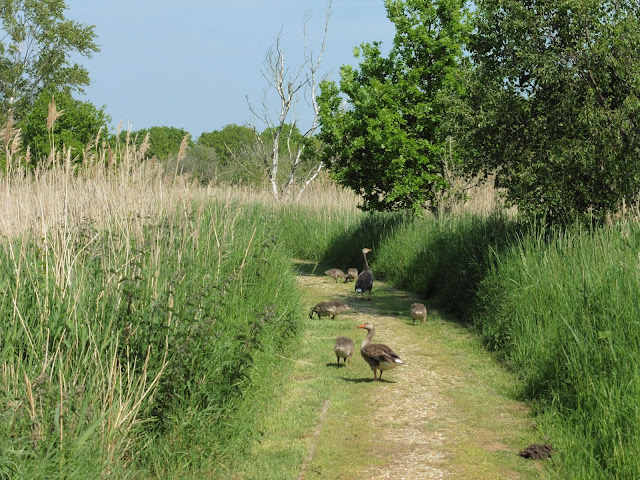Swallowtails and a boat trip were the two suggestions from visiting Honeyguiders Everard and Phil. A day out at Hickling, with local Honeyguiders, was the obvious plan for what turned out to be a warm early summer’s day.
With the group assembled and the boat trip paid, our morning was a circuit on foot around Hickling Broad nature reserve. We were in no hurry to leave the picnic area as a female broad-bodied chaser perched in fine view on a cigar gall on a reed. The gall was explained by Ann as initially the home for Lipara lucens, a type of frit fly, with other invertebrates moving in later. Very nearby was a gloriously golden four-spotted chaser, posing beautifully for photos.
 |
| 'A gloriously golden four-spotted chaser.' |
There was bird song everywhere, more like spring than summer, willow warblers and reed warblers especially. There were also plenty of perched reed buntings to find, once we’d found our past the greylag goose family on the path. On some open water we watched a male hairy dragonfly, then a Norfolk hawker. It didn’t take long to see swallowtail butterflies flying past us, about three sightings while we were on foot, though none settled for close views, perhaps related to the warm weather.
 |
| Greylags on the path around the nature reserve at Hickling. |
Various galls on oak trees, endless marsh harrier sightings and an over-flying hobby were among the wildlife on the next stretch, plus a chance encounter with Honeyguide leader Rob Lucking on a day out with his wife Vicki. This brought us to the bank alongside bittern hide. The hide was occupied but it didn’t matter: we heard a distant bittern from deep in the reeds anyway. On Brendan’s marsh there were two little egrets, lapwings and avocets among a carpet of yellow buttonweed (Cotula).
An
NWT tractor on the track meant a path through the wood was the easier route
back to base, past the koniks (ponies) that are part of the reserve’s management
team.Konik, a pony breed from Poland often used to help manage wetland nature reserves.
Honeyguider Gill Page joined us for packed lunches in the picnic area, during which some saw a red kite fly over (I was in the loo!). We then made our way to the launching area for the boat Swallowtail. Sanitiser and life jackets sorted, we were away. The route took us across Hickling Broad, with its hundreds of non-breeding mute swans and many sightings of marsh harriers and common terns, plus two great white egrets. Once in a narrower waterway, more swallowtail butterflies flew around us as we made our way to the below sea level island with its tree tower. Those of us that climbed to the top of the tower had great views across the Hickling and Horsey area.
 |
| All aboard the 'Swallowtail'. |
We returned to the visitor centre for ice cream and cold drinks, during which Rachel Frain from NWT said how she was trying to re-build the volunteer team at NWT Hickling’s visitor centre, a team which has, as in so many walks of life, taken a hit with Covid, closures and so on. If anyone reading this blog would like to volunteer on this lovely reserve, please ask Chris at Honeyguide or contact Rachel directly (rachelf@norfolkwildlifetrust.org.uk).
We then walked along the other side of Brendan’s marsh towards Stubb Mill. Redshanks called and we found avocet chicks with their parents. At the far end there was a confusing moment: I said “crane” just as Helen called “bittern”. The bittern was flying high across the reedbed before dropping out of sight, soon followed by its distinctive ‘boom’. I was beginning to wonder if I had imagined a crane-like shape when it reappeared, on an earth bank at the end of a waterway. A second crane showed briefly, too.
 |
| View from the tower towards Whiteslea Lodge, Hickling. |
From the raptor viewpoint at Stubb Mill there were several marsh harriers and a buzzard as we scanned towards Horsey Mill and the tumbledown Brograve Mill. It was time to return after a long but rewarding day out.
Chris
Durdin





No comments:
Post a Comment